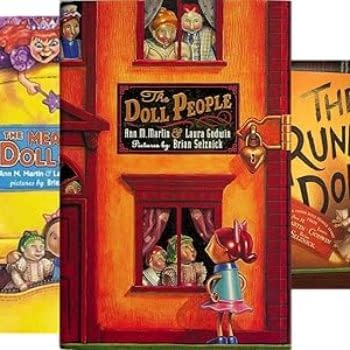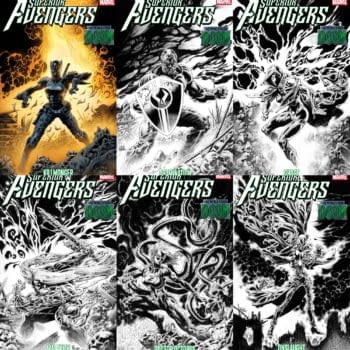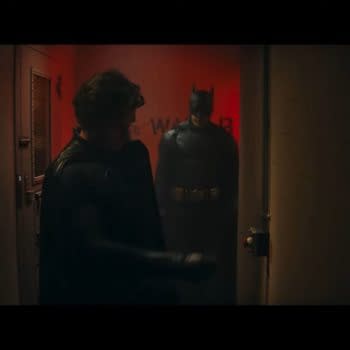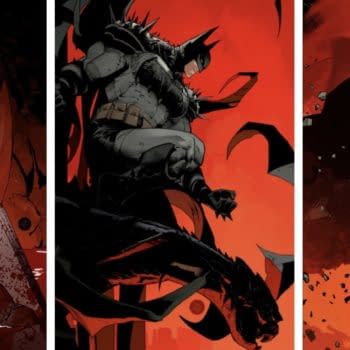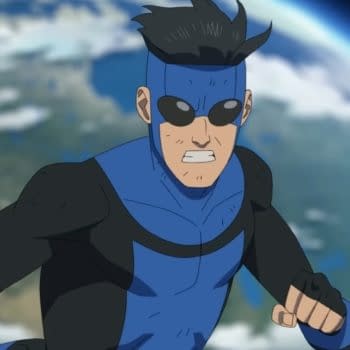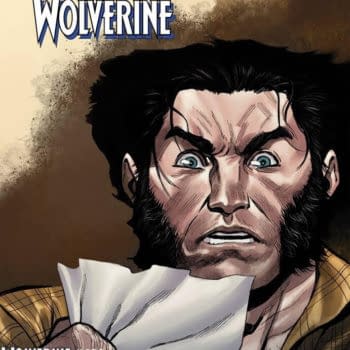Posted in: Comics | Tagged: Comics, dynamite, lone ranger
Ande Parks' Lone Ranger Commentary For Issues 1 To 3
So there you are, reading the new Lone Ranger series from Dynamite and you woinder to yourself "what was the writer thinking?". Wonder no more, author Ande Parks takes you through the first three issues, page by page.
ISSUE ONE
PAGE ONE
First, I have to get something off my chest. One snark-filled review of this first issue pointed out that there was no such thing as the "Oklahoma Territory" until 1890. As a writer who prides himself on research and adding historical touches to my fiction, this hurt! I concede the point, and was aware of that inaccuracy when I wrote this first caption box. While I do place importance on research and accuracy, I also think we are here to tell a story. An engaging story about heroic fictional characters. I made the conscious decision that cheating the facts a bit was good for the story. "Oklahoma Territory, 1870" reads better and is less distracting than "The unorganized territory that would eventually become Oklahoma, 1870." That chip lifted from my shoulder… let's proceed.
It took me a long time to find a narrative device I liked for the opening of this book. I wanted to do something that got right to our narrative, but that also let the reader in on our theme: that the old west was a brutal landscape in which life was often cheap (but that a few good men could make a real difference). Once the idea of a newspaper editorial came to me, I wasted a few hours searching for an actual clipping. With the time gone forever, I made up an editorial.
As an aside, I shared my fake editorial with my pal and soon-to-be best-selling author, Alex Grecian, just to see if he thought I had captured the style of the era. Alex kindly offered a few suggestions.
Great coloring here by Marcelo Pinto. I love the torchlight against the dark blue night.
PAGE TWO
In reaching out for a name that seemed authentic for a settler from the East, I settled on the surname of my friend Dan Jurgens. Dan actually noticed and teased me about it when the book came out. I apologized for what I did to his fictional wife. We're cool now. No more name-dropping.
I wanted the death of Martha Jurgens to play very fast and chaotic… like these horrible circumstances almost couldn't be avoided. These bad guys haven't come here with murder in mind, necessarily. It just happened. That's the nature of life on the plains, far away from the nearest legal authority.
I must confess that I love that "harshly earned" line at the end of the editorial. Lincoln, KS is a real town in central Kansas. The town had pretty well-respected newspaper by 1882.
PAGE THREE
Intentionally asked Esteve to pay homage to the final shot of "The Great Train Robbery". He did so very well. The John Ford quote came from our fantastic editor, Joe Rybandt. I asked if he had a good quote relating to vengeance/justice. I know we're relying on a lot of narrative tricks here, between the fake editorial, the Ford quote and the upcoming letter overlay. Maybe I laid it on a bit thick. I will confess to a little "pulling out all the tricks for the first issue" syndrome.
I wanted to show Lone Ranger doing some target practice, in part to point out how hard it is for him to take down bad guys without killing them.
PAGE FOUR
I decided on this "letter as narration" device early on. It's something I've done before. I think it's a very effective tool in the modern era of comics, in which a omniscient author's voice is frowned upon stylistically. In this case it's a virtual letter… the letter Jurgens never writes down, but has composed in his head.
I didn't realize it until after this issue was complete, but our story here became a weapon in my ongoing war against what I think has become the easy but unrewarding crutch of too many comic book scripts: cleverness. I read a lot of comics that leave me feeling nothing but, "Well, that was… clever." These comics don't deliver what I value most in any art form: they don't move me. Without intending to make a statement on this trend, I constructed a first issue for Lone Ranger that put the emphasis on emotion over clever. There is no twist ending here. There is just, as best as I could deliver it, a story of loss and hope, with our hero as the instrument of change between the two.
PAGE FIVE
I asked a lot of Esteve on these quiet pages of desperation. I didn't hesitate, because I know what he's capable of. He draws real people in real environments so well. He draws them with a sense of staging an composition that few have. These quiet pages tell their quiet story without being dull. He's fantastic. I also know that I can call for settings like this crude home without going crazy with detail. Esteve fills in enough texture and detail to make the scene real.
I am proud of Jurgens' voice in the letter narration. It was a tough call, juggling how I thought he would speak with how he might write if he actually composed this letter.
PAGE SIX
I named Jurgens' daughter after my grandmother, who grew up in Kansas some thirty-five years after our story. She lived with death in a way I can only imagine. I gave young Kathryn a doll based on a detail my mother provided about her own childhood. These children would have clung desperately to the few possessions they could call their own.
Amazing coloring of the flames here by Marcelo. The reflection of the flame against the rocks in the final panel is also quite nice.
PAGE SEVEN
I wanted to convey that these children have been brought up with so much hardship that they almost don't have time to grieve for their mother. They have noticed the loss, but going to pieces about it just isn't realistic. Or, they might just be in shock. I won't complain either way your want to see it.
It's subtle, but this last panel should raise the possibility that Jurgens is considering an easy way out for himself and his children. Earlier versions of the script had Jurgens mention that they could rejoin Martha in a better place. I thought that was too spot on, so I dropped it.
By the way, our wonderful letterer Simon Bowland did a great job with the font on Jurgens' narrative.
PAGE EIGHT
I love this page. The hint of something happening in the first panel, without a sound effect to tip the action. Esteve's fantastic reveal of Lone Ranger. The Ranger holding Silver's reins in his teeth. The incredible coloring. Enough. I like it.
PAGE NINE
Our first panel shows what will be a recurring theme in our book: Lone Ranger tries to disarm bad guys by shooting their guns out of their hands, but it's impossible to do so cleanly every time. Sometimes a serious wound is left behind. Sometimes that wound has serious consequences.
I love the guy in the last panel already raising his hands in surrender. Didn't take long for him to realize he's had enough. I also like the overall pacing here. Lone Ranger has done this before. He acts without hesitation.
I fully realize we didn't address how Lone Ranger might have known that he would be needed here at this time. I considered adding some stuff about him getting word of a shooting the night before, and then checking out the farm, hence being in the right place at the right time. In the end, though, I decided to leave it mysterious. Since we're seeing this through Jurgens' eyes, I think the mystery works.
PAGE TEN
I know Tonto gets a short shrift here. I wanted to focus on the singular vision of Lone Ranger, appearing to the Jurgens family as a savior on a white horse. I thought having Tonto on the perimeter of the action, watching for fleeing bad guys, made some strategic sense. Rest assured, none of this signals that we intend to downplay Tonto in this series.
PAGE ELEVEN
This page is about the random, cruel nature of Jurgens' loss. His wife has died over an eight dollar dispute. This was inspired by the Clutter murders, which Truman Capote documented in his masterpiece, "In Cold Blood". Having written a graphic novel about Truman's struggle to write that book, it's a subject I'm very familiar with. The Clutter's murderers left behind four bodies. The robbery that started the crime netted the killers about twenty dollars.
PAGE TWELVE
Lone Ranger would never have allowed Jurgens to pull that trigger. Still, he wants Jurgens not pulling it to feel like a choice.
You could say this is the second sucker punch for Tonto in this issue. I think he's just being humane.
PAGE THIRTEEN
I doubt Tonto is thrilled about tending to these men's wounds. Such is a partnership!
More gorgeous coloring. I need to write more scenes with flames!
Here's the crux of the whole issue. Lone Ranger has already made a difference by saving the lives of Jurgens and his family. That's meaningless, though, if Jurgens isn't strong enough to go on from here.
PAGE FOURTEEN
In my original pitch, each issue of our series featured a flashback sequence. We will eventually drop this premise, but I think this one works very well. We get to revisit Lone Ranger's origins without a whole issue's recap.
This issue was built around the premise of a tragedy that mirrors the loss Lone Ranger has faced… the loss that shaped him. Now we get to dive into the parallels.
I don't know if the dialogue of Lone Ranger's dying mother works entirely. I wanted her to be delusional in her fever…
PAGE FIFTEEN
… until her final moments alone with here sons, where she snaps back to herself for just an instant. Her dying moments are of concern for the men she loves.
I'm also very fond of James Reid's stoic nature here. As re-imagined in just a few issues by Brett Matthews and company, he's a fantastic character.
PAGE SIXTEEN
I confess that this leisurely pacing flies against what I generally want to do. I think it's worth it for that splash of tiny John Reid against that huge full moon. Another intended homage here: this time it's the doorway at the end of John Ford's "The Searchers". You haven't seen it? Go… please. This column will still be here when you get back.
PAGE SEVENTEEN
Maybe James Reid wiping a tear at his wife's grave is a bit much? Given the chance, I might tweak that fourth panel.
I love the way Esteve framed the two Reids against the full moon in the middle of the page. The composition of the final panel is also very nice.
PAGE EIGHTEEN
I wanted James Reid's last word, "Always…" to hover over the image of him being shot in this first panel. Lone Ranger's origin story in four panels. That's a strong origin. Thanks, Fran Striker.
There's an old writer's cliché that says you should dump lines you're especially proud of. Well, I'll admit that I'm quite proud of Lone Ranger's speech about what we owe the dead that starts on this page. Glad I kept it.
PAGE NINETEEN
I just wanted to reflect on Lone Ranger's allegiance to his father's legacy here. Plus, I knew Esteve would kill on the splashy image at the grave site. He did. Add more killer coloring and it ends up being a pretty striking page.
PAGE TWENTY
This is what makes Lone Ranger a hero. It's not how well he rides or shoots or punches. It's about his example. He is an upright man who strives not to compromise his principles in a world that assaults them daily. That man can make a difference. It's true now and it was true in 1870.
PAGE TWENTY-ONE
With the bad guys apprehended, I had to decide what the heck Lone Ranger and Tonto would do with them. There's no local jail to throw them into. So, a journey to real justice, which is a hard ride away. This leads directly into our next issue.
We make it clear here that Lone Ranger is moving on, but that he's no abandoning the Jurgens family. How thorough will his follow-up be? Give us enough time and we may well get to that.
I confess to grinning like an idiot as I typed "Hi-yo, Silver!" Hell, I'm grinning writing about writing it.
PAGE TWENTY-TWO
I wasn't sure about doing this final page as a splash. There's no action… just a family looking off toward an uncertain future. Still, I wanted this moment to stand out. It is what we're here to say: Lone Ranger has given this family hope. I think it has the impact I was hoping for. Visually, I needn't have worried. Esteve and Marcelo knocked this out of the park, and Simon's title lettering is perfect.
Is ending Nathan's narration with the arc's title too on the nose? I hemmed and hawed about it, but I'm glad I left it in there.
These stand-alone issues are tougher to write, just because you have to think of that many more ideas. I felt strongly that our first issue should be one-and-done. Our second issue will continue that trend. Starting with number three, we get into broader arcs. I hope to continue this kind of balance as we move forward.
ISSUE TWO
PAGE ONE
In my original pitch for this new Lone Ranger series, I had a five or six page flashback sequence built into every issue. I thought it would provide opportunity to revisit the character's pasts in a way that would connect to the theme of our new stories. We could hint at origins without doing a straight origin recap. I eventually tired of losing those pages to the current stories I was telling, but we open with the device in our second issue.
I knew Esteve would draw the hell outta Tonto running through trees and leaping down to a river's banks. I was right. I'm smart that way. Colors by Marcelo Pinto are especially nice in this sequence, too.
I set this about three years before our current continuity. Long enough that Tonto was still with his tribe. He was not yet a lone figure roaming the prairie. Our second arc, "Native Ground" will deal with Tonto's "origin" story: what drove him to leave his tribe behind. It's something Brett Matthews and company hinted at in the previous Lone Ranger series. We're going to dig deeper.
PAGE TWO
Guys with knives rolling around in water. That's a good visual in any medium.
To be honest, we have struggled with Tonto's tribal origins. If you research Tonto online, it would seem that he is a Pottawatomie. The Pottawatomie lived primarily in the Great Lakes area. While many would be relocated to the west, they would not get as far as the desert areas that would seem to best suit our Tonto. So, I've been fudging a bit… not naming his tribe specifically. Frankly, while I love filling our book with historical details, I kind of like keeping Tonto's tribal identity more universal.
The brave with the bow here is Beshkno. Matthews depicted him as a proud, somewhat bitter brave from Tonto's tribe. He's less bitter at this stage, but still clearly more temperamental than Tonto.
PAGE THREE
More gorgeous coloring by Marcelo. God… that water in panel two. Great staging by Esteve Polls throughout. He is such a gifted storyteller. No matter how complex I make things, I never have to worry that the art will be hard to follow. That's an amazing gift to a writer. How great is panel four? Great choice in using this low angle, with the knife dropping toward us. That was not in the script. My art direction for that panel consisted of:
"Tonto turns back to Wabanim's body. Tonto tosses his knife down into the muddy earth next to the river. He is disgusted."
I wanted to use Tonto to say something about how his culture views killing as opposed to the cold-blooded gunfighter we'll meet in this issue. Tonto's last line here gets at that. It's not important who this brave they were tracking was, or how he betrayed the tribe. What matters for our purposes is how Tonto views the death of a man he had reason to resent. There is nothing heroic here, in contrast to how our gunfighter will be viewed by the public in the rest of this issue.
PAGE FOUR
Okay, I know I cheated a bit, having Lone Ranger and Tonto ride with their prisoners from Oklahoma to Abilene in a few days. Hell with it. I wanted to write Kansas.
This page really shows off the always-wonderful work of our letterer, Simon Bowland. Again, everyone on this book places storytelling first. As it should be.
I struggled with a device to provide context for our gunfighter. The Almanac idea really clicked for me once I hit on it. I love the idea that this Almanac would be an old book for our readers, but a blast from the future for our characters.
I love Woodson showing total disdain for the town's no-gun rule.
PAGE FIVE
This page is all about showing how "on the clock" Woodson has to be, all the time. He lives with the possibility of someone drawing on him around the clock. He allows himself to "deflate" a bit in panel five, in the relative peace and safety of his room, but not until he's set a glass by the door and his gun close at hand.
PAGE SIX
Lone Ranger does not kill. Period. He does fire his guns a lot, though. He shoots guns out of hands on a pretty regular basis. I don't think that hand-shot should be a given. I think Lone Ranger hits his targets, for the most part, but I think the bullet often rips through the bad guy's flesh, which was a helluva would in a world that offered little proper medical care. Hence our first panel. Lone Ranger didn't mean to seriously injure this man, but he may well lose his hand due to infection. Also… a little foreshadowing: see the last page of this issue.
I wanted to get the real Marshal of Abilene, Tom Smith, out of town for this story. His presence would have interfered with our story too much. Smith is a very interesting figure. I may try to get back to him down the line…
PAGE SEVEN
More background provided on Woodson, and more glimpses of the life he's forced to live. Esteve does a great job with Woodson puffing himself up for the public in that last panel.
PAGE EIGHT
This is one of my favorite pages of Lone Ranger we've done thus far. It shows how Lone Ranger's fame is growing, ponders whether this is a good or a bad thing, shows how kids look up to gunfighters of all type, and lets Tonto get in a great zinger in the last panel. And, Lone Ranger telling the kid to watch his language may be my favorite thing I've written for him. I gotta move on. This is getting immodest.
PAGE NINE
Obviously, this page is all about pointing out how our two heroes see civilization in very different ways. Honestly, it might be a little wordy for Tonto, but it works. I like the dynamic Tonto outlines here: his people seeking harmony with nature while the white man tries to beat it into submission.
Lovely last panel. Fantastic work by Esteve and Marcelo.
PAGE TEN
A little Lone Ranger counterpoint to Tonto. Of course, Tonto gets the last word. I think this page is a nice example of having the characters "do something" as they talk. It's not a lot, but walking to the barn to get Tonto's horse is a lot more interesting that two guys just standing around. Of course, Esteve stages it all so well.
PAGE ELEVEN
All right… we've gone too long without some action. Bear with me. It's coming. Esteve does a good job with this bar/restaurant setup. It's tricky to make it familiar without resorting to every Hollywood Western cliché. I like the tablecloths on the dining tables at the edge of the room. That's a touch I don't recall seeing before. Again, not in the script.
I like the way the Almanac text works with the art to create a feeling that Woodson is always watching, and that something is building here. Dropping the names of real Old West figures in the Almanac text helps give Woodson some more weight.
PAGE TWELVE
Woodson sees the trouble before it starts. He'd just as soon not kill anyone, but he's ready. He also doesn't give a damn about being honorable. He kills the kid without standing or even showing his weapon. The kid is coming after Woodson. The kid dies. That simple. The kid's last words here hint that there is another shooter. Of course, the dying kid could be talking about his brother. That's probably what Woodson thinks at first…
PAGE THIRTEEN
In panel two, the kid's dying words combine with the sound of a gun being cocked to tip Woodson off to another shooter. The script specified that this shooter is carrying a weapon that required noise before firing. Hence the rifle and the shooter's long coat (for obscuring the weapon).
Woodson acted without hesitation, but he's not thrilled that his stay in Abilene will be so brief. He's not eager to hit the trail again.
PAGE FOURTEEN
I like Lone Ranger running his hand over the mattress, anticipating his good night's sleep in a real bed. I try not to have the Ranger swear much, but the symmetry of his "Damn." after Woodson's was too nice to resist.
This kind of crowd scene, with the Ranger parting the crowd in the final panel, is the kind of thing that's easy in film but tough in comics. Esteve does is perfectly.
PAGE FIFTEEN
Again, panel two is tough to pull off. Thanks to Esteve and Simon, I think Jimmy's nervousness and Lone Ranger's calm plays really well. I like Ranger saying "You did good" instead of "You did well". The Ranger usually speaks well, but this feels natural.
Love the silhouette of Lone Ranger in that final panel.
PAGES SIXTEEN TO EIGHTEEN
The big talk! This story came from a simple idea: Have Lone Ranger meet a tough old gunfighter. Have our hero who does not kill come up against a man whose life is defined by killing. It's a clash of two ideologies, and of two ways our culture sees its heroes. Woodson has been reading men for a long time. His life has depended on reading men… seeing what they're capable of in an instant. He reads Lone Ranger well, at least as seen through Woodson's eyes.
By the way, I wasn't crazy about separating Lone Ranger and Tonto for this issue. Tonto didn't get a lot of "screen time" in our first issue, and I was worried about giving the impression that we were minimizing him in our new book. I just thought he would throw off the dynamic between Lone Ranger and Woodson too much. Starting next issue, Tonto's presence become more integral.
PAGE NINETEEN
Really setting the stage for Lone Ranger's dilemma here. He can't let Woodson face the angry mob or there will be more bloodshed. He also can't just gun Woodson down. Again, Woodson's posture in panels three and four says it all. He's tired, but he puffs himself up before opening that door.
PAGE TWENTY
Lone Ranger is fast. I think he's close to as fast as Woodson was in his prime. He's faster than Woodson as an old, tired man. I thought we might get some push-back about how Lone Ranger solves this ethical dilemma, but it seemed to fly with all involved.
PAGE TWENTY-ONE
Lone Ranger is a thinking man. He knows Woodson will continue to cause death wherever he goes. Eventually, Woodson himself will get shot down. Lone Ranger takes Woodson's gun-fighting ability away from him here. He's giving Woodson a chance at something different. Will Woodson take it?
Love this last shot of Lone Ranger. So heroic. Damn! Have I mentioned how lucky I am to be working with Esteve?
PAGE TWENTY-TWO
I think it's a bit tricky to flash forward in our continuity, but I didn't see any other way. Since it's one page, and no one mentions Lone Ranger, I think it works. Woodson has made the most of the opportunity provided by Lone Ranger's bold action. That's what our first two issues have been about. It's what this whole "Hard Country" arc is about: the Old West was a tough place, but one bold hero (or two, as the case may be) can still make a big difference.
Remember that killer's infected hand on page six? Now we see that Woodson lost an arm after being shot by Lone Ranger. I don't want gunshots to be meaningless in our stories. There are consequences when you pull that trigger. This time, it worked out for the best overall.
I love the poignancy of that last panel. I'm fond of the ghost line in the Almanac text, and Esteve nailed the shot of Woodson. The porter drops Woodson's new name, letting us know why he vanished from the history books before leaving the Wild West behind.
LONE RANGER #2 Deleted Scene
I initially wrote this final page for Lone Ranger #2. I like it, but I decided it was too similar to the framing sequence for the final issue of the Lone Ranger: The Death of Zorro series. I scrapped it in favor of the page at the train station that made the final cut. I like the new version. It fits the Woodson character better. Still, this one has its charm.
1 page
The future. A state fair in Kansas or nearby. A younger wife brings old Gun a lemonade. Sets it on a table next to him. He's here to meet people and sell/sign his little autobiographical book. One arm is gone above the elbow. The other he can handle pretty well. A kid comes in, awed. Asking about killing. Asking if it's true that Gun met LR. That LR was real. Gun smiles… final line. Wife in the shot. It has been a good life for Gun.
22.1
Establishing shot of a fairgrounds in western Kansas, circa 1900. It's a good-sized fair for the day: lots of animals in display, along with games of skill and attractions. There are many attractions, from freaks to semi-famous characters of the old west. The fair is pretty crowded on a hot summer day.
CAPTION
Kansas State Fair. 1898.
22.2
In a tent that houses a number of the attractions, we see an attractive and well-dressed woman of about sixty-five carrying a glass of lemonade. She moves toward an old man who sits in a folding chair. The man is Woodson, aged seventy-eight. We can't see him well. We just see an old man in a black suit in a chair. There is a small table next to Woodson's chair. The table holds a stack of Woodson's autobiography: a short, hardbound book of a hundred pages or so. An attendant mans the tent's flap/door.
WOMAN
Clay…
22.3
The woman hands Woodson the glass of lemonade. Woodson takes it with an old, shaking hand.
WOMAN
Clay… I brought you a lemonade. It's time to open the tent. Ready to sell some pamphlets?
WOODSON
Thank you, Ellen.
WOODSON
Ready as an old man can be.
22.4
With the tent open, a line of people stream into the tent. First up is an enthusiastic boy of about nine. The boy is with his mother. Both are pretty well-dressed. The fair is a big deal. Woodson's wife is in the shot. She steps up a bit here.
MOTHER
This is him, son. This man was a real gunfighter.
WOODSON'S WIFE
Marshal. My husband was a marshal.
WOODSON
Hell, Ellen… it's all right.
22.5
Tight on Woodson and the boy. We still have not really seen one of Woodson's arms… keep it hidden for now.
WOODSON
I was a Marshal in the old west, son. A gunfighter, too, I guess.
WOODSON
Wanna ask me anything? Don't imagine you'll get another chance.
BOY
Yessir. Did you ever meet anyone famous in the wild west?
22.6
Tight on Woodson as we see, for the first time, that he is missing an arm. The arm Lone Ranger shot in the upper arm didn't survive the injury. Woodson's jacket is pinned up to the shoulder on that side. Woodson smiles. We can see at least part of his lovely wife in the shot, as well.
WOODSON
Famous? Yeah… met a man once… some folks called him the Lone Ranger. Got pretty famous in his time.
WOODSON
In fact, I owe the man. I owe him… everything.
Issue 3
PAGE ONE
Our first two issues were stand-alones, fit into the theme of our six-issue arc. This third issue kicks of a three-parter, and moves us more to an old-fashioned, plot-driven "how the hell is our hero going to get out of that" story.
This whole story started with an idea for this first scene, which I suppose I shouldn't spoil until the next page.
Esteve does a wonderful job drawing these small Western towns. They look real, and they look very isolated out in the middle of these vast landscapes… which is kind of the point of our "Hard Country" arc.
I wanted a quote to open this story that dealt with how we view god. I started with Mark Twain and didn't have to search long to find something appropriate. The town sign I made up. Just something to let you know what kind of town our new villain has created.
PAGE TWO
We will never get into super detail when it comes to the exact nature of Dorsey's plot. I didn't see the need. I think you'll get plenty of details as we progress. I'm not interested in all the machinations. I want to pit Lone Ranger and Tonto against a man who does awful thing under the name of two things Lone Ranger holds dear: God and The Law.
Here's the reveal that drove this whole story: Lone Ranger at the business end of a hanging rope.
Fantastic colors here, as usual, by Marcelo Pinto. I'm so thrilled with the team our editor, Joe Rybandt assembled for this book. I love the hinted background elements in our third panel. It subtly enriches the panel without distracting your eye. Same with the mountains in the background of our half splash.
PAGE THREE
We jump back in time to find Lone Ranger and Tonto on the trail, as few days after the events of our second issue. It was tempting to write more for them in Abilene, but I wanted to jump ahead and get them into contact with a new character efficiently. We can always go back to Abilene later on.
Tonto knows everything he needs to know about these approaching riders just by looking them over from several hundred yards away. Of course he does.
Love the detail in this final panel. Don't blame Esteve for drawing those roasting prairie dogs. It was in the script. I know they're cute, but I bet they're also tasty.
Big panel. Pull out to show the whole campsite. Lone Ranger crouches behind his own saddle near where Tonto lies. A campfire has been built and lit, and a couple of prairie dog carcasses rest over the fire, impaled on sticks that form a makeshift rotisserie. There might also be a pot of beans or other food next to the fire. A pot of coffee also sits near the fire. In the distance we can see what Tonto was aiming at: a couple of riders approaching. The riders are white men, still small in the distance, maybe two hundred yards away.
PAGE FOUR
Winston Marle was introduced in the Brett Matthews/Sergio Cariello/John Cassaday Lone Ranger run. Brett and company left Marle out there for future run-ins with Lone Ranger, and I thought he'd be a handy way to drive the Ranger and Tonto into conflict against Dorsey. We're going to be seeing a lot more of Agent Marle.
That poor guide is going to have to just watch Tonto as he devours that prairie dog!
Marle is playing Lone Ranger here. I don't think the fact that Lone Ranger falls for this line makes him naive. He's just not a political animal, as Marle is. Our hero will become much more savvy in upcoming issues.
PAGE FIVE
Again, I'm so lucky to have Esteve on this book. I don't have to constantly ask him to mix up the type of shots he draws for visual interest. He knows enough to mix things up. It really pays off in scenes like this, where it's just two people walking and talking.
Marle is really laying it on here, mentioning the death of a child. He knows Lone Ranger can't say no to that.
This page touches on a theme we touched on in issue two, and will explore more fully down the line a bit. I assume that Lone Ranger would start to build a reputation. Like it or not, his exploits would garner some attention in the press. In our third arc, we'll look more at whether or not that's a good thing.
Wow… what a final shot by Esteve and Marcelo. I did ask for a chasm at Lone Ranger's feet, to symbolize the abyss he's stepping into here. I didn't specify that it be this gorgeous.
PAGE SIX
I did a fair amount of research about how Old West bank robberies actually worked. I settled on the most common method for Marshal Dorsey and company: having a few men already on the train, so they could force it to stop at a spot where their cohorts could board.
Took me awhile to figure out all this exposition about the robbery in a few panels. I like this method of disinformation from the traumatized crowd. Of course, Tonto cuts right through all the crap. Six men, riding this way.
PAGE SEVEN
This page is about how good Tonto is as a tracker. The Ranger himself is a decent tracker, for a white man. Tonto is something else, altogether. He's also not above pointing all this out to Lone Ranger. Yeah, I was thinking of Butch and Sundance as I wrote this sequence. How could you not?
PAGE EIGHT
Great transition here in the coloring, as we move into a night scene. It's easy to make these scenes too dark and muddy. Marcelo does a great job keeping the tone just right for a vast landscape with a bright moon above.
I don't want to get too super-powered with Tonto's knowledge of his surroundings. The man is well-traveled. We'll explore why soon enough.
Again, as we did in issue two, a little reminder that Tonto views civilization very differently than the Ranger.
PAGE NINE
Again, the palette by Marcelo is beautiful. He really captures that sunrise light.
Poor robbers… no bacon. The Old West really was a tough place.
Nice job by Esteve, making the robbers' camp look convincing in just one shot. That's wall you can ask for: your artist to use that one establishing shot well, wherever it may fall in the scene, so you can focus on the characters the rest of the time. We just need a sense of a real space for these people to move around in.
PAGE TEN
No, bad guys will never stop drawing on Lone Ranger. It's like those dudes who always have to take a shot at Superman. At least they can't throw the guns at him after, because he's already shot it out of their hands.
Lone Ranger will cleanly shoot the gun out of a hand about fifty percent of the time in our book. The rest of the time the gun is still dropped, but some blood is drawn. These odds change if Lone Ranger is riding full speed, etc.
I love panel four. So strong and self-assured. Kind of has a John Wayne quality, right?
PAGE ELEVEN
I specified the white hat for Dorsey. Just wanted to play with the good guy image a bit.
Dorsey takes his name from a friend of mine. My friend is not at all a megalomaniac with delusions of grandeur. He just has one of those names that seems authentic to the period. Also, his dad is a big Lone Ranger fan.
PAGE TWELVE
Reading this page makes me wonder if I did the right thing having Tonto's shooting play out in two panels. It might have been more shocking to see the shot and the impact all at once. Noted for the future.
PAGE THIRTEEN
What does a man yell when he sees his friend shot? I struggled mightily with that question. I had Lone Ranger scream Tonto's name. I had him saying nothing. I tried it all. Still not sure this "NO!" cuts it.
Note that this time the hand-gun shot draws blood.
PAGES FOURTEEN TO NINETEEN
As I've said about previous issues, my original concept for this book called for a flashback sequence in every issue. This time I thought we'd look back at how John Reid sees the badge. I liked the opportunity to see James Reid in action. James is a helluva Ranger and a good man. He's also a bit cruder than his son, who attended Harvard.
To be honest, there are a few choice words in this scene I probably wouldn't use again. I know we can use some adult language in this book, but as I've gotten to know the fan base better I've grown more uncomfortable with it. I don't know… not making any promises. I still do think this killer would probable say "Shit." if he saw James Reid coming.
James Reid is calm and cool… until he gets close enough to deck this stupid bastard who is holding a gun on him.
Also, notice that James Reid wears about the same hat his son will wear as the Lone Ranger. Nice touch by Esteve.
After knocking out the killer, James Reid should have been muttering to himself, not speaking out loud. I blew that.
PAGE TWENTY
I love transitions like this, from the badge in the past to Lone Ranger's seized badge now. Not subtle, but it gets the point home. This stolen symbol means everything to Lone Ranger. Having it taken by a man who hides behind his own, corrupted version of the badge adds insult to injury.
I want to point out that making Dorsey a villain with delusional beliefs about the bible is in no way a shot at religious faith. As we'll get to later on, Lone Ranger is a man of faith. He, unlike Dorsey, believes in a loving, forgiving god. John Reid absolutely believes that he'll see his family again. To be honest, I base a lot of Lone Ranger's values on my Grandfather's.
PAGE TWENTY-ONE
Dorsey hints at how Lone Ranger has been played by Marle. More on that in our next issue. I love the Sunday hanging. Nothing better than a pious, cold-blooded villain with absolute faith in his own bullshit.
PAGE TWENTY-TWO
Esteve draws this page so well. The distance down into the chasm is real and terrifying. I also love the way Tonto has fallen.
These men don't really see Tonto as a human… not a human the same way they are. He doesn't believe in their god. He certainly doesn't deserve a proper burial. He's all but an animal in their eyes. The line about the coyotes reinforces that belief. "Just toss the dirty savage back to nature, and let things play out as they should."
I hope our first cliffhanger proves appropriately frustrating. We're on schedule, so you won't have to wait that long to see if/how our heroes make it.





































